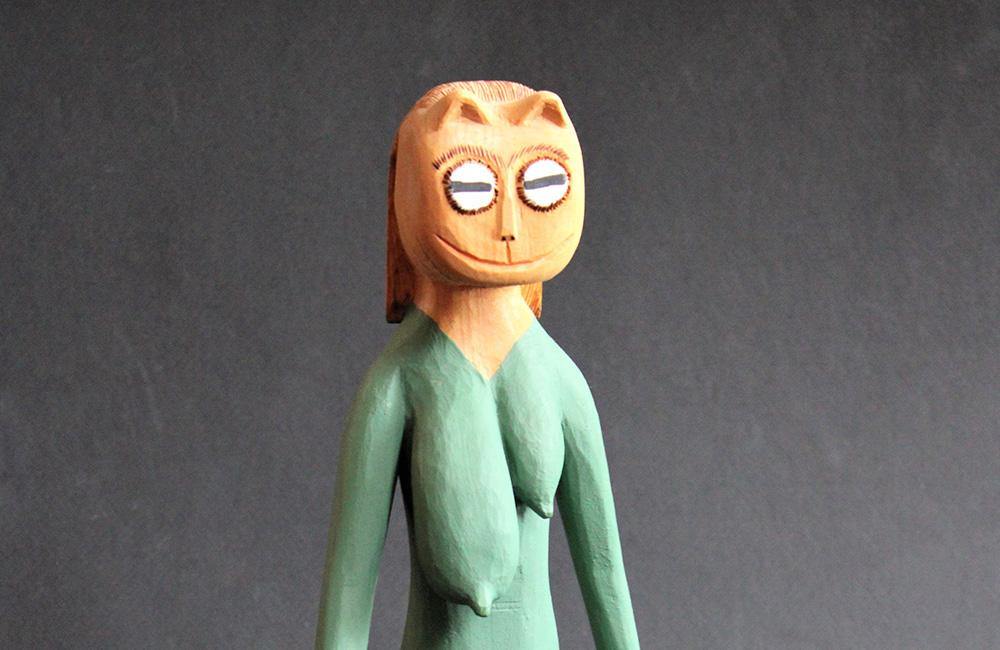First published: Summer 2019
Inspired by the everyday world and nature, Sulton Rogers' carvings are often humorous and macabre but they also have a poignant edge
Well-endowed women wearing bikinis and tight, figure-hugging dresses; men dressed to the nines in business suits and tuxedos; blues singers; couples engaged in X-rated embraces; devils, vampires, and werewolves. These, among many others, are the denizens of the outlandish imagination of contemporary folk artist Sulton Rogers. There is an untold number of Rogers’ small-scale statues, all with an unexpected twist, often humorous or bizarre, sometimes grotesque or dark. He often gave his figures exaggerated, bizarre facial features, such as the Tongue Waggers (on front cover) with their elongated, slithering tongues and huge teeth. He made hybrid creatures, such as the Hawk Guys, Lion Man and Cat Lady. He was interested in “haints”, a Southern word for ghosts, which he portrayed as intense and sometimes misshapen, and occasionally placed in large doll-house structures that he called “haint houses”. He carved the dead in coffins – containers for jewellery, he said, meant to scare off thieves.
 Devil Family, c. 1990s, painted wood carvings, height from 6.5 in. (16.5 cm) to 12 in. (30 cm), courtesy: Perez Art Museum, Miami, gift of Gordon W Bailey
Devil Family, c. 1990s, painted wood carvings, height from 6.5 in. (16.5 cm) to 12 in. (30 cm), courtesy: Perez Art Museum, Miami, gift of Gordon W Bailey
Sulton (sometimes misspelled as “Sultan”) Rogers was born in 1922 in Mississippi, near the university town of Oxford. As a boy, he was taught to carve animals and canes by his father, a skilled whittler, but it would be many years before he took up carving again. At 27, he left Mississippi and travelled throughout the Mid-West looking for work. He joined the Army, was stationed in Texas between 1943 and 1944, and finally settled in Syracuse, New York, in 1952, where he worked as a carpenter. In 1970, he was hired as a machine operator at the company Allied Chemical where he worked until his retirement in 1984. It was during night shifts there that he began carving again.
In the 1980s, during one of his trips home to Oxford, he met the folklorist William R Ferris, founding director of the Centre for the Study of Southern Culture at the University of Mississippi and, later, Chair of the National Endowment for the Humanities. As Rogers told it: “I came down South to my sister’s house on vacation an’ I was carryin’ some carvings in a box to my nieces and nephews. Ferris saw ‘em and bought ‘em and they never did get to those children!” Ferris became a keen collector of Rogers’ work and later donated his collection to the University Museum of Mississippi, which houses over 200 of Rogers’ works and where a permanent display is planned for later this year.
Rogers liked using soft woods, such as sugar pine, to carve his statues, which range in size from several centimetres to nearly a metre. He began by “squaring out” a block of wood with a saw, often identifying details in pencil, then using a pocketknife to carve. Sometimes he left figures untouched, in the natural colour of the wood, while at other times he lightly shellacked them. On occasion, he used latex paint to colour them. He also used a wood-burning tool to add detail to hair and facial features.
This is an article extract; read the full article in Raw Vision #102




